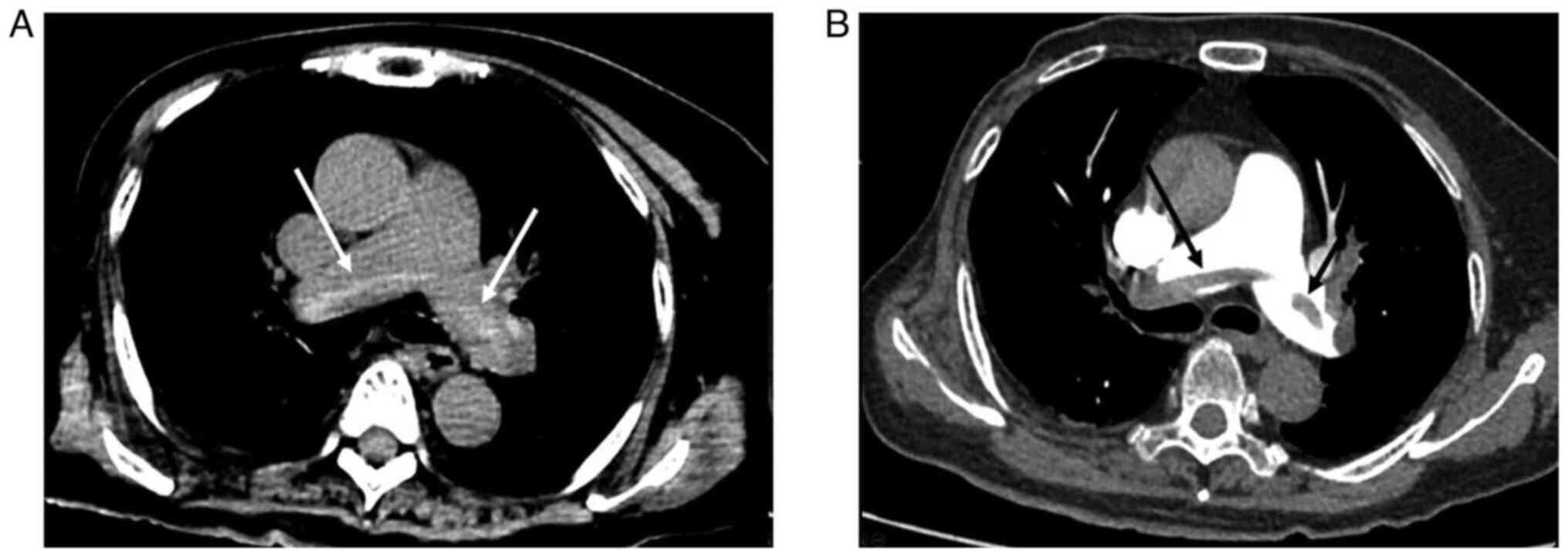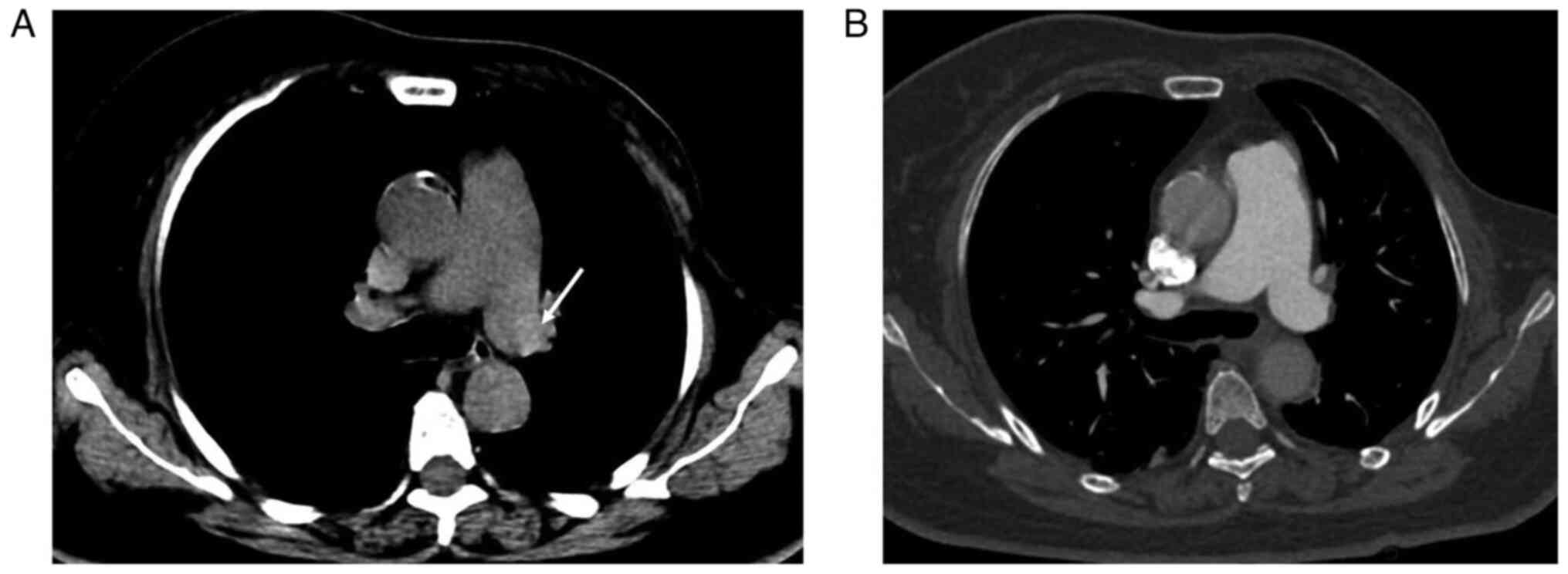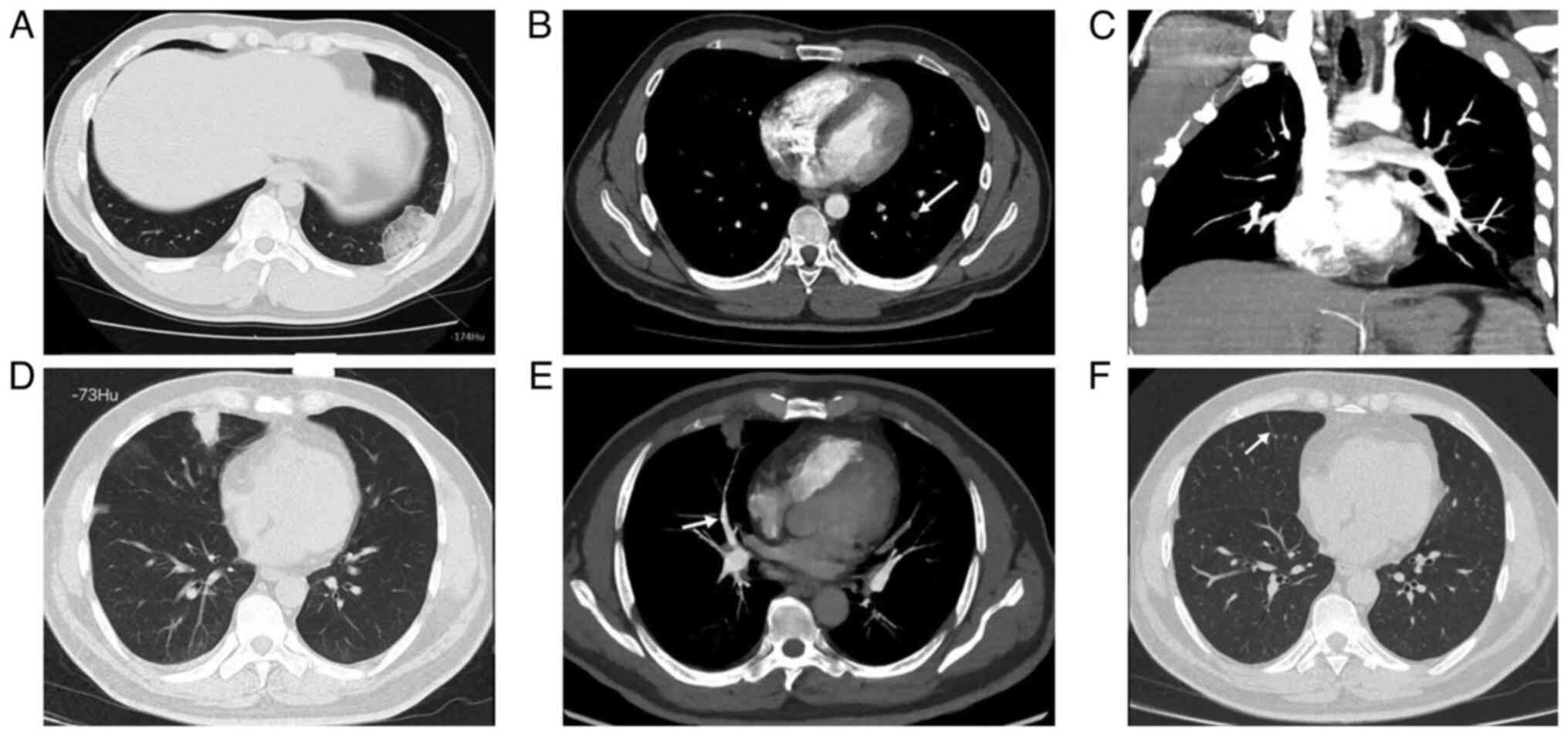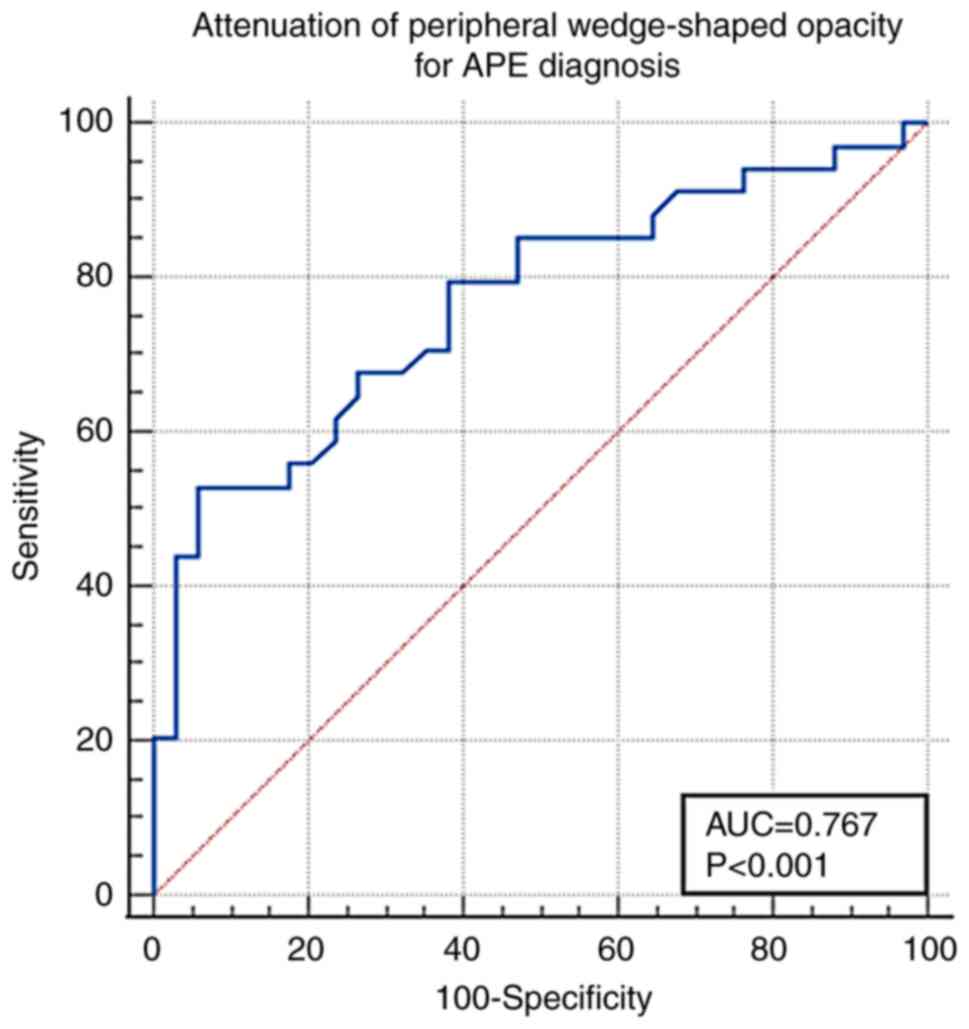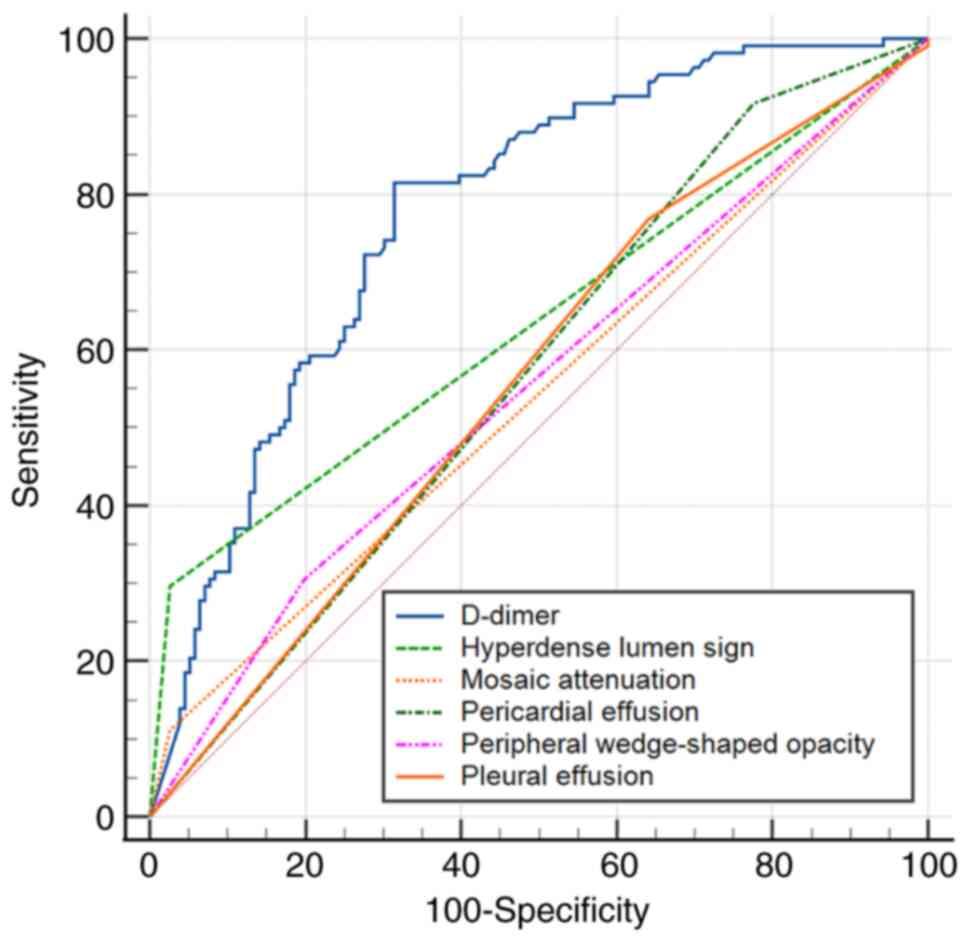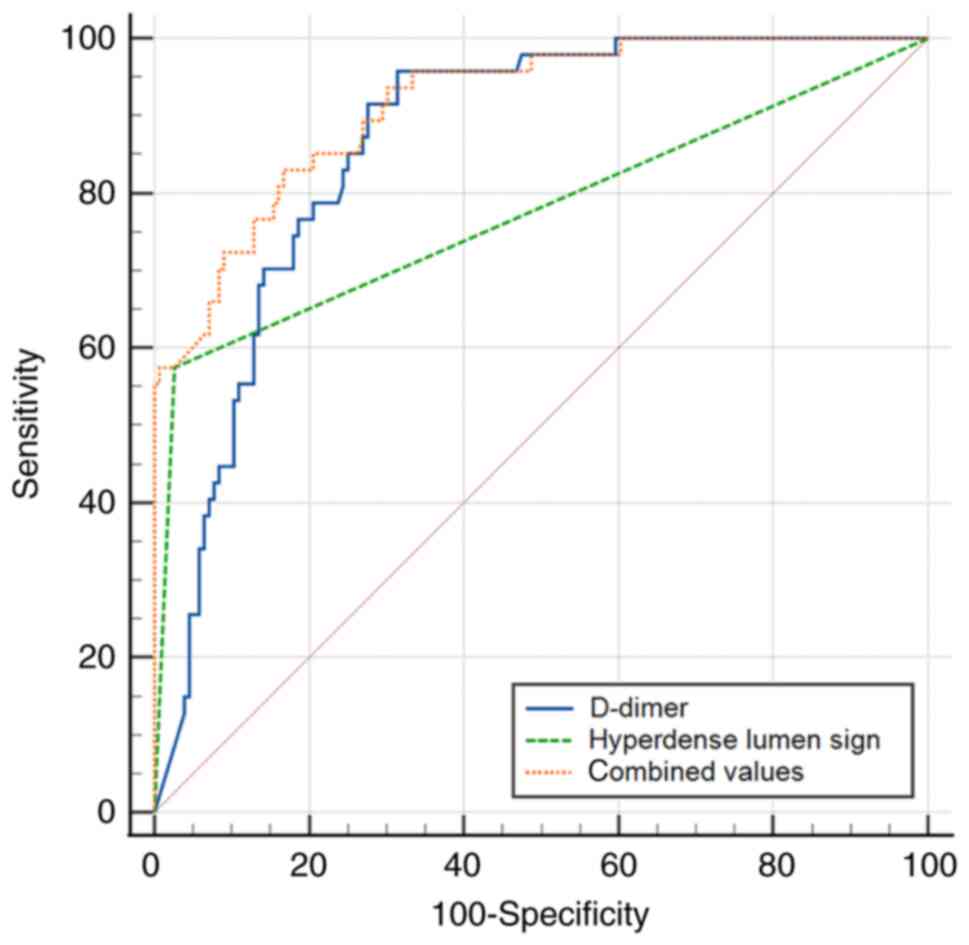Chest non‑contrasted computed tomography in detecting acute pulmonary thromboembolism: A single‑center retrospective study
- Authors:
- Published online on: May 29, 2024 https://doi.org/10.3892/etm.2024.12593
- Article Number: 304
-
Copyright: © Guo et al. This is an open access article distributed under the terms of Creative Commons Attribution License.
Abstract
Introduction
Venous thromboembolism, clinically including deep vein thrombosis (DVT) and pulmonary thromboembolism (PE), is one of the most common cardiovascular diseases, second only to myocardial infarction and stroke (1). The annual incidence of PE ranged from 39 per 100,000 (in Hong Kong) to 115 per 100,000 population (in the United States) (2). There is a large number of predisposing factors associated with acute PE (APE) including DVT, lower-limb fractures, joint replacements, surgery, spinal cord injury, cancer and other weak risk factors (3,4). The most common symptoms of APE include dyspnea, chest pain, cough, hemoptysis, syncope and fever (5). Due to the wide range of non-specific clinical symptoms and signs, rapid and accurate diagnosis of APE is a big challenge (6). Computed tomography pulmonary angiography (CTPA) has been the gold standard for the diagnosis of APE (7,8). This method visualizes the clot in the pulmonary artery as a filling defect in the lumen. However, compared with CTPA, chest non-contrasted CT (NC-CT) is a convenient and cost-effective procedure and often performed for the evaluation of non-specific chest symptoms in emergency cases. Chest NC-CT is not considered to be an effective method for APE diagnosis, however, some studies reported that the hyperdense lumen sign on chest NC-CT might be a sign of APE (9,10). In addition, chest NC-CT has recently been used in patients with COVID-19 pneumonia, and the incidence of APE was relatively high in patients with COVID-19 pneumonia (11). The aim of the present study was to review imaging features of APE on chest NC-CT, and comprehensively analyze the value of NC-CT in detecting APE.
Materials and methods
Study population
This is a single-center retrospectively observational study which was approved by the ethics committees of China-Japan Friendship Hospital (Beijing, China; approval no. 2022-KY-048-1) and performed in accordance with the Declaration of Helsinki. Informed consent was waived for this retrospective study. All patients who first underwent chest NC-CT and then CTPA within 24 h between January 2018 and October 2022 were enrolled in this study. Patients with poor image quality of CTPA due to severe motion artifacts or the low-contrasted enhancement of pulmonary artery were excluded. Patients who were diagnosed with chronic PE (CPE), chronic thromboembolic pulmonary hypertension, non-thrombotic PE, pulmonary artery sarcoma and Takayasu arteritis as shown in their electronic medical records were excluded. The clinical information of all patients was recorded using their medical charts and all patients were treated at standard clinical practice. Clinical characteristics of the patients are given in Table I.
CT scan protocols
All patients underwent both chest NC-CT and CTPA on multidetector CT [Toshiba Aquilion ONE 320 (Canon Medical Systems Corporation) or GE Revolution CT (GE Healthcare)] within 24 h. All the scans ranged from pulmonary apices to the diaphragm with a craniocaudal direction. The slice thickness and interval of NC-CT was 5 mm.
Parameters for CTPA scanning were as follows: 120 kV; 100-300 mA, 0.8 sec rotation time, 0.625-1-mm-thick slices, and 0.625-1-mm slice interval. Patients received a bolus of 70-ml non-ionic contrast (Ultravist; 370 mg I/ml; Bayer AG), followed by a 50-ml saline flush at a rate range of 4-4.5 ml/sec. The scanning delay time was determined using the contrast agent automatic detection trigger technique, which positioned the target at the level of the main pulmonary artery with a predefined threshold of 100 Hounsfield units (Hu), and fixed 5-sec delay scanning.
Imaging analysis
All CTPA images were reviewed by a chest radiologist with 12 years of experience on picture archiving and communication systems (RG). APE was divided into central type and peripheral type based on the clot distribution. Central APE was diagnosed when a filling-defect was observed in the main pulmonary artery, left or right pulmonary artery trunk and peripheral APE is defined as a clot in the interlobar artery, lobar artery and segmental artery (12).
All NC-CT images were reviewed by two radiologists who were blinded to the original CT report, CTPA and clinical diagnosis (MD and ML). The presence of APE and imaging findings including the hyperdense lumen sign, peripheral wedge-shaped opacity, mosaic attenuation, pleural effusion and pericardial effusion were determined by the consensus of the two chest radiologists who had 10 and 16 years of experience, respectively. The hyperdense lumen sign is defined as a high-density foci in the pulmonary artery on NC-CT (13), that has a higher density than the blood in the heart cavity (Fig. 1). Peripheral wedge-shaped opacity is a roughly triangular or wedge-shaped high-density area, with a wide base attached to the pleural surface and the apex pointing towards the hilum, which can be ground glass opacity, mixed density, or complete solid density (14) (Fig. 2).
A radiologist with 7 years of experience reviewed NC-CT and CTPA together (WX). If the hyperdense lumen sign on NC-CT was confirmed as APE by CTPA, the attenuation value of the clot on NC-CT was measured. This was completed by selecting the slice that best displayed the high-density clot and placing a circular region of interest (ROI) on it. The attenuation value of the blood pool was measured by placing a circular ROI on the main pulmonary artery, while referring to the CTPA image to avoid the area of the clot. The area of peripheral wedge-shaped opacity was manually circled on the lung window, which was used as ROI to measure the average attenuation value. The average attenuation value on ROI was recorded. The mean attenuation values between high-density clots and the main pulmonary artery were compared, as well as the attenuation value of peripheral wedge-shaped opacity between patients with and without APE. The diameters of the main pulmonary artery and ascending aorta and their ratio were measured and compared between patients with and without APE.
Statistical analysis
Categorical data were expressed as percentage and compared using χ2 test or Fisher's exact test. Continuous variables were expressed as mean ± standard deviation and a unpaired Student's t-test was performed. If continuous variables did not conform to normal distribution, they were expressed as median with an interquartile range and compared using the Mann-Whitney U test. The aforementioned analysis was performed using SPSS (version 17.0; SPSS Inc.). The receiver operating characteristic (ROC) curve analysis was used to determine the area under the curve (AUC) using MedCalc (version 20.019; MedCalc Software Ltd). P<0.05 was considered to indicate a statistically significant difference.
Results
Clinical characteristics
A total of 289 patients underwent NC-CT and CTPA within 24 h. Of these, 16 patients were excluded due to poor image quality (six patients) and CPE (10 patients), resulting in 273 patients (131 men and 142 women; mean age, 64.3±18.0 years, with a range of 20-93 years) being included in the present study. The clinical characteristics of patients with and without APE are shown in Table I. Among the included patients, there were 110 patients with APE and 163 patients without APE. Among 59 patients with APE, DVT of lower limbs was present, which was higher than that of patients without APE (P<0.001). No in-hospital mortality was reported. Age, sex and clinical symptoms between patients with APE and patients without APE were comparable (P>0.05). The D-dimer of patients with APE was significantly higher than that of patients without APE (P<0.001). When referring to the age-adjusted D-dimer cut-off value (age x0.01 mg/l), there was a decrease of eight D-dimer positive cases for patients >50 years old, who had no APE confirmed by CTPA. Both C-reactive protein and N-terminal pro B-type natriuretic peptide (NT-proBNP) were comparable between patients with APE and patients without APE (P>0.05).
There were 49 patients with central APE and 61 patients with peripheral APE. Table II shows that the age and sex of patients in the central and peripheral APE groups were similar. D-dimer and NT-proBNP in patients with central APE were significantly higher than those of patients with peripheral APE (P<0.05).
Chest NC-CT findings and D-dimer in patients with and without APE
Table III shows chest NC-CT findings in patients with and without APE. The hyperdense lumen sign was found in 33/110 patients with APE on NC-CT (Fig. 1), while the hyperdense lumen sign was found in 4/163 patients without APE (false positive; P<0.001; Fig. 3). Thus, the hyperdense lumen sign had a sensitivity and a specificity of 30.0 and 97.6%, respectively, in detecting APE. The mean attenuation of high-density clots was significantly higher than that of the main pulmonary artery (67.0±9.9 Hu vs. 37.8±6.6 Hu; P<0.001; Fig. 4). Although the peripheral wedge-shaped opacity in 34 patients with APE (30.9%) and 34 patients without APE (20.9%) was comparable, the mean attenuation value of peripheral wedge-shaped opacity in patients with APE was significantly lower than that of patients without APE (Fig. 5). The cut-off value of the peripheral wedge-shaped opacity attenuation for APE diagnosis was -125 Hu [AUC, 0.767±0.058; 95% confidence interval (CI), 0.649-0.861; sensitivity, 52.9%; specificity, 94.1%; P<0.001; Fig. 6].
According to ROC, the cut-off value of D-dimer for prediction of APE was 2.49 mg/l (AUC, 0.776±0.029; 95% CI, 0.721-0.825; sensitivity, 81.5%; specificity, 68.6%; P<0.001). ROC (Fig. 7) indicated that the AUC of the D-dimer was higher than that of the hyperdense lumen sign (AUC, 0.635±0.023; 95% CI, 0.574-0.693), peripheral wedge-shaped opacity (AUC, 0.549±0.036; 95% CI, 0.488-0.609), mosaic attenuation (AUC, 0.543±0.017; 95% CI, 0.481-0.604), pleural effusion (AUC, 0.562±0.028; 95% CI, 0.500-0.623), pericardial effusion (AUC, 0.571±0.021; 95% CI, 0.508-0.631) in the diagnosis of APE.
Chest NC-CT findings and D-dimer in central and peripheral APE
Chest NC-CT findings in patients with central and peripheral APE are shown in Table IV, indicating that the frequency of hyperdense lumen sign in central APE was higher than in peripheral APE (P<0.001), but other CT findings revealed no statistical difference between the two groups. Table V indicated that 28 patients with central APE and five patients with peripheral APE showed hyperdense lumen sign. The sensitivity and specificity of the hyperdense lumen sign in detecting central APE were 57.1 and 97.6%, respectively, while they were 8.2 and 97.6%, respectively, in detecting peripheral APE. Furthermore, the AUC of the combination of the hyperdense lumen sign and D-dimer (AUC, 0.915±0.022; 95% CI, 0.868-0.950; sensitivity, 83.0%; specificity, 83.3%, P<0.001) was higher than either of them (Fig. 8) in detecting central APE.
Table VComparison of non-contrasted CT findings and D-dimer in diagnosis of central APE and peripheral APE. |
Discussion
In the present study, the value of NC-CT in the diagnosis of APE was evaluated, and the following findings were reported: i) The hyperdense lumen sign had a sensitivity of 30.0% and specificity of 97.6% in detecting APE; ii) the sensitivity and specificity of the hyperdense lumen sign in detecting central APE were 57.1 and 97.6%, respectively, while these were 8.2 and 97.6% in detecting peripheral APE; the hyperdense lumen sign was found to be a valuable diagnostic indicator for central APE, whereas it may not be useful for diagnosing peripheral APE; iii) although the peripheral wedge-shaped opacity on NC-CT was comparable between patients with and without APE, the mean attenuation value of peripheral wedge-shaped opacity in patients with APE was significantly lower than that of patients without APE; and iv) the age-adjusted D-dimer had higher specificity in excluding APE.
APE is one of most frequent acute cardiovascular diseases (15). Identifying the predisposing factors is important in the assessment of patients with suspected APE. However, the predisposing factors were comparable between patients with and without APE in the present study, except DVT of lower limbs.
For the diagnosis of APE using NC-CT, the effectiveness of the hyperdense lumen sign as an indicator has been the subject of various studies. Tatco et al (10) reported an overall sensitivity and specificity of the hyperdense lumen sign in detecting APE of 36 and 99%, respectively. By contrast, Ehsanbakhsh et al (13) reported a sensitivity of 42.5% and a specificity of 98.6% of the hyperdense lumen sign in detecting APE. However, Chien et al (16), found that the sensitivity of NC-CT for diagnosis of central APE was 72.9%, which is markedly higher than the results observed in the present study. These discrepancies across different studies can be attributed primarily to variations in sample sizes and the inclusion criteria used. It is noteworthy that most existing studies have concentrated on central APE, with only a limited number of studies providing a comprehensive analysis that includes both central and peripheral APE (10,13). This divergence in focus and methodology underscores the complexity of accurately diagnosing APE and highlights the need for further research that encompasses a broader spectrum of APE manifestations. The value of the hyperdense lumen sign in both central and peripheral APE was first assessed. The sensitivity of the hyperdense lumen sign in detecting peripheral APE was only 8.2% in the current study. Calcified lymph nodes around the hilar are particularly prone to cause the false hyperdense lumen sign. The hyperdense lumen sign in the peripheral pulmonary artery is affected by partial volume averaging, motion artifact and image noise, resulting in a decline in the accuracy of the assessment. Consequently, the hyperdense lumen sign on NC-CT is a valuable indicator for central APE, however, its usefulness in detecting peripheral APE is limited. Moreover, when the hyperdense lumen sign and the D-dimer were combined, the diagnostic performance of detecting central APE was substantially improved. This finding indicates that patients presenting with hyperdense lumen sign in the central pulmonary artery may not require further CTPA examination.
The hyperdense lumen sign depends on the density contrast between thrombus and blood. The findings of the present study revealed that high-density clots within the main pulmonary artery exhibited a mean attenuation value significantly greater than that of blood, aligning with the observations made by Kanne et al (9) who provided a benchmark attenuation value for acute thrombosis. However, the density of the clots is determined by their composition, mainly including red blood cells and fibrin. When the thrombus contracts, the water in it will decrease, which concentrates hemoglobin and increases the attenuation value of the clot (16). With the degradation of red blood cells and fibrin in the embolus, the density of the clot will gradually decrease (17). The average attenuation value of acute emboli <8 days old was ~66 Hu on NC-CT, whereas those >8 days old had a lower attenuation of 55 Hu (18). Hematocrit is also an important factor that affects the density of embolus and blood pool (19). These factors collectively contribute to the low sensitivity of the hyperdense lumen sign in detecting central APE. The dynamic changes in emboli density over time, influenced by their composition and the physiological processes of contraction and degradation, present challenges in the consistent detection of APE using the hyperdense lumen sign. Understanding these intricacies is essential for interpreting NC-CT images accurately and improving the diagnostic approach for APE.
Among other CT abnormalities, peripheral wedge-shaped opacity is frequently reported in APE. This is considered to represent pulmonary infarction (20). In pulmonary infarction, the density of the peripheral wedge-shaped opacity is often a mixture of ground glass opacity and consolidation, and central lucencies are often observed (21). However, peripheral wedge-shaped opacity is not specific for diagnosing pulmonary infarction as it can also be seen in pneumonia, tumors, or other diseases. The current study found that the frequency of peripheral wedge-shaped opacity between patients with and without APE was similar, however, the mean attenuation value of peripheral wedge-shaped opacity in patients with APE was significantly lower than that in patients without APE. The peripheral wedge-shaped opacity cut-off value for APE was -125 Hu (AUC, 0.767), with high specificity. Thus, the peripheral wedge-shaped opacity in a mixture of ground glass opacity and consolidation indicated the pulmonary infarction which requires further CTPA confirmation. Mosaic attenuation, pleural effusion and pericardial effusion are not sufficient to distinguish APE from other diseases.
Previous studies have found that the increase of D-dimer is closely associated with APE (22,23). The current study also found that the D-dimer of patients with APE was higher than that of patients without APE. Moreover, the D-dimer of patients with central APE was also higher than that of patients with peripheral APE. A large multinational study showed that age-adjusted D-dimer had higher specificity in excluding APE (24). In the current study, D-dimer positive cases decreased according to the age-adjusted D-dimer which minimized the need for CTPA, thereby decreasing radiation exposure and complications associated with contrast agents. Furthermore, when the hyperdense lumen sign and the D-dimer were combined, the diagnostic performance for detecting central APE was substantially improved. This finding indicated that patients with the hyperdense lumen sign in central pulmonary artery and increased D-dimer may not require further CTPA examination.
Compared with previous studies (9,10,13,17), the present study provided a comprehensive evaluation of the value of chest NC-CT in detecting APE, which included not only the assessment of central APE but also peripheral APE, offering a more complete analysis of the condition. It was found that combining the hyperdense lumen sign with D-dimer levels improved the diagnostic performance for detecting central APE, which was a novel approach not widely explored in previous studies.
Although the current study included a relatively large number of cases, there are some limitations. Since this is a single-center retrospective study, a thinner slice thickness on NC-CT cannot be obtained and only 5-mm-thick slices were used to evaluate the hyperdense lumen sign, so hyperdense lumen sign in peripheral APE must be underestimated. Magnetic resonance imaging (MRI) has emerged as a valuable alternative to CTPA in the evaluation of APE, particularly in patients with contraindications to iodinated contrast or in pregnant or young patients (25). In a future study, the bright-blood static steady-state free precession sequences in the diagnosis of APE will be analyzed. Artificial Intelligence has been applied to disease diagnosis based on CT or MRI. A deep learning model may be developed for predicting APE based on NC-CT and clinical data in a future study.
Although chest NC-CT cannot replace CTPA in diagnosing APE, the hyperdense lumen sign had high specificity in diagnosis of central APE. Patients with this sign on NC-CT and the increased D-dimer may not require further CTPA. The lower attenuation value of peripheral wedge-shaped opacity on NC-CT strongly suggested APE and required CTPA confirmation. Age-adjusted D-dimer had higher specificity in excluding APE.
Acknowledgements
Not applicable.
Funding
Funding: The present study was supported by the CAMS Innovation Fund for Medical Sciences (grant no. 2022-I2M-C&T-B-109), the National Natural Science Foundation of China (grant no. 82272081) and the Medical and Health Science and Technology Innovation Project of the Chinese Academy of Medical Science (grant no. 2021-I2M-1-049).
Availability of data and materials
The data generated in the present study may be requested from the corresponding author.
Authors' contributions
ML participated in the research design. RG, MD, LX, SZ and WX performed the experiments and collected data. RG, MD, LX and SZ analyzed the data and were major contributors in writing the manuscript. RG, MD, SZ, WX and ML confirm the authenticity of all of the raw data. All authors read and approved the final manuscript.
Ethics approval and consent to participate
The present single-center, retrospective cohort study was performed according to the Declaration of Helsinki and was approved by the Ethics Committee of China-Japan Friendship Hospital (approval no. 2022-KY-048). Informed consent was waived.
Patient consent for publication
Not applicable.
Competing interests
The authors declare that they have no competing interests.
References
|
Raskob GE, Angchaisuksiri P, Blanco AN, Buller H, Gallus A, Hunt BJ, Hylek EM, Kakkar A, Konstantinides SV, McCumber M, et al: Thrombosis: A major contributor to global disease burden. Arterioscler Thromb Vasc Biol. 34:2363–2371. 2014.PubMed/NCBI View Article : Google Scholar | |
|
Wendelboe AM and Raskob GE: Global burden of thrombosis: Epidemiologic aspects. Circ Res. 118:1340–1347. 2016.PubMed/NCBI View Article : Google Scholar | |
|
Anderson FA Jr and Spencer FA: Risk factors for venous thromboembolism. Circulation. 107 (Suppl 1):I9–I16. 2003.PubMed/NCBI View Article : Google Scholar | |
|
Chew HK, Wun T, Harvey D, Zhou H and White RH: Incidence of venous thromboembolism and its effect on survival among patients with common cancers. Arch Intern Med. 166:458–464. 2006.PubMed/NCBI View Article : Google Scholar | |
|
Pollack CV, Schreiber D, Goldhaber SZ, Slattery D, Fanikos J, O'Neil BJ, Thompson JR, Hiestand B, Briese BA, Pendleton RC, et al: Clinical characteristics, management, and outcomes of patients diagnosed with acute pulmonary embolism in the emergency department: Initial report of EMPEROR (multicenter emergency medicine pulmonary embolism in the real world registry). J Am Coll Cardiol. 57:700–706. 2011.PubMed/NCBI View Article : Google Scholar | |
|
Raja AS, Greenberg JO, Qaseem A, Denberg TD, Fitterman N and Schuur JD: Clinical Guidelines Committee of the American College of Physicians. Evaluation of Patients With Suspected Acute Pulmonary Embolism: Best practice advice from the clinical guidelines committee of the American college of physicians. Ann Intern Med. 163:701–711. 2015.PubMed/NCBI View Article : Google Scholar | |
|
Stein PD, Fowler SE, Goodman LR, Gottschalk A, Hales CA, Hull RD, Leeper KV Jr, Popovich J Jr, Quinn DA, Sos TA, et al: Multidetector computed tomography for acute pulmonary embolism. N Engl J Med. 354:2317–2327. 2006.PubMed/NCBI View Article : Google Scholar | |
|
Hou DJ, Tso DK, Davison C, Inacio J, Louis LJ, Nicolaou S and Reimann AJ: Clinical utility of ultra high pitch dual source thoracic CT imaging of acute pulmonary embolism in the emergency department: Are we one step closer towards a non-gated triple rule out? Eur J Radiol. 82:1793–1798. 2013.PubMed/NCBI View Article : Google Scholar | |
|
Kanne JP, Gotway MB, Thoongsuwan N and Stern EJ: Six cases of acute central pulmonary embolism revealed on unenhanced multidetector CT of the chest. AJR Am J Roentgenol. 180:1661–1664. 2003.PubMed/NCBI View Article : Google Scholar | |
|
Tatco VR and Piedad HH: The validity of hyperdense lumen sign in non-contrast chest CT scans in the detection of pulmonary thromboembolism. Int J Cardiovasc Imaging. 27:433–440. 2011.PubMed/NCBI View Article : Google Scholar | |
|
Roncon L, Zuin M, Barco S, Valerio L, Zuliani G, Zonzin P and Konstantinides SV: Incidence of acute pulmonary embolism in COVID-19 patients: Systematic review and meta-analysis. Eur J Intern Med. 82:29–37. 2020.PubMed/NCBI View Article : Google Scholar | |
|
de Monyé W, van Strijen MJ, Huisman MV, Kieft GJ and Pattynama PM: Suspected pulmonary embolism: Prevalence and anatomic distribution in 487 consecutive patients. Advances in new technologies evaluating the localisation of pulmonary embolism (ANTELOPE) group. Radiology. 215:184–188. 2000.PubMed/NCBI View Article : Google Scholar | |
|
Ehsanbakhsh A, Hatami F, Valizadeh N, Khorashadizadeh N and Norouzirad F: Evaluating the performance of unenhanced computed tomography in the diagnosis of pulmonary embolism. J Tehran Heart Cent. 16:156–161. 2021.PubMed/NCBI View Article : Google Scholar | |
|
Shah AA, Davis SD, Gamsu G and Intriere L: Parenchymal and pleural findings in patients with and patients without acute pulmonary embolism detected at spiral CT. Radiology. 211:147–153. 1999.PubMed/NCBI View Article : Google Scholar | |
|
Duffett L, Castellucci LA and Forgie MA: Pulmonary embolism: Update on management and controversies. BMJ. 370(m2177)2020.PubMed/NCBI View Article : Google Scholar | |
|
Chien CH, Shih FC, Chen CY, Chen CH, Wu WL and Mak CW: Unenhanced multidetector computed tomography findings in acute central pulmonary embolism. BMC Med Imaging. 19(65)2019.PubMed/NCBI View Article : Google Scholar | |
|
Cobelli R, Zompatori M, Bresciani P and De Luca G: Visualization of hypoattenuation clots on unenhanced CT of the thorax. AJR Am J Roentgenol. 182:530–531. 2004.PubMed/NCBI View Article : Google Scholar | |
|
Yankelevitz DF, Gamsu G, Shah A, Rademaker J, Shaham D, Buckshee N, Cham MD and Henschke CI: Optimization of combined CT pulmonary angiography with lower extremity CT venography. AJR Am J Roentgenol. 174:67–69. 2000.PubMed/NCBI View Article : Google Scholar | |
|
Foster M, Nolan RL and Lam M: Prediction of anemia on unenhanced computed tomography of the thorax. Can Assoc Radiol J. 54:26–30. 2003.PubMed/NCBI | |
|
Kaptein FHJ, Kroft LJM, Hammerschlag G, Ninaber MK, Bauer MP, Huisman MV and Klok FA: Pulmonary infarction in acute pulmonary embolism. Thromb Res. 202:162–169. 2021.PubMed/NCBI View Article : Google Scholar | |
|
Revel MP, Triki R, Chatellier G, Couchon S, Haddad N, Hernigou A, Danel C and Frija G: Is it possible to recognize pulmonary infarction on multisection CT images? Radiology. 244:875–882. 2007.PubMed/NCBI View Article : Google Scholar | |
|
Kline JA, Hogg MM, Courtney DM, Miller CD, Jones AE and Smithline HA: D-dimer threshold increase with pretest probability unlikely for pulmonary embolism to decrease unnecessary computerized tomographic pulmonary angiography. J Thromb Haemost. 10:572–581. 2012.PubMed/NCBI View Article : Google Scholar | |
|
Riley RS, Gilbert AR, Dalton JB, Pai S and McPherson RA: Widely used types and clinical applications of D-Dimer assay. Lab Med. 47:90–102. 2016.PubMed/NCBI View Article : Google Scholar | |
|
Righini M, Van Es J, Den Exter PL, Roy PM, Verschuren F, Ghuysen A, Rutschmann OT, Sanchez O, Jaffrelot M, Trinh-Duc A, et al: Age-adjusted D-dimer cutoff levels to rule out pulmonary embolism: The ADJUST-PE study. JAMA. 311:1117–1124. 2014.PubMed/NCBI View Article : Google Scholar | |
|
Kalb B, Sharma P, Tigges S, Ray GL, Kitajima HD, Costello JR, Chen Z and Martin DR: MR imaging of pulmonary embolism: Diagnostic accuracy of contrast-enhanced 3D MR pulmonary angiography, contrast-enhanced low-flip angle 3D GRE, and nonenhanced free-induction FISP sequences. Radiology. 263:271–278. 2012.PubMed/NCBI View Article : Google Scholar |



